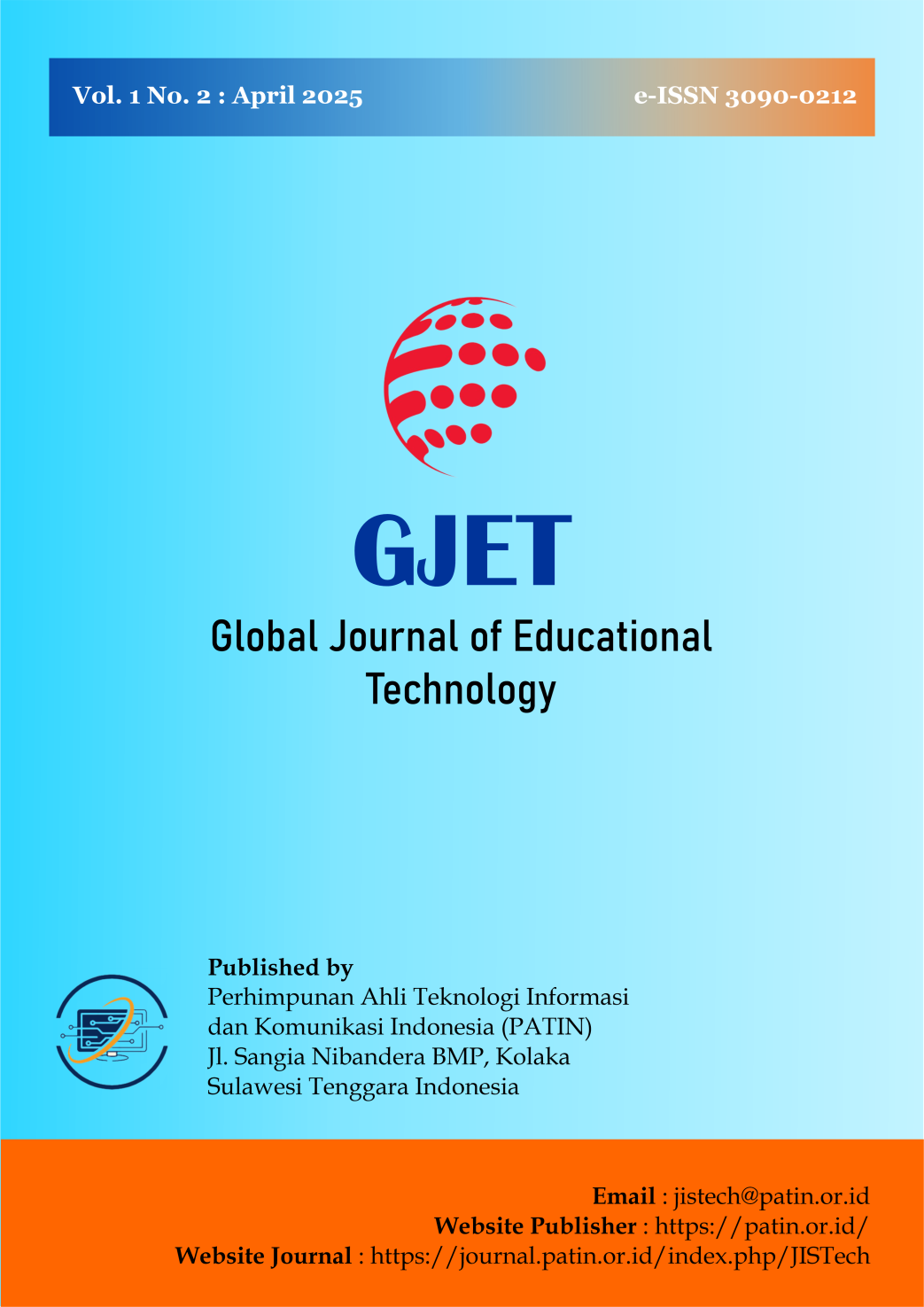Evaluasi Keberhasilan Layanan Bebas UKT USN Kolaka Menggunakan Metode Technology Acceptance Model
DOI:
https://doi.org/10.71234/gjet.v1i2.65Keywords:
technology acceptance model, bebas UKT, PLS-SEM, sistem informasiAbstract
Penelitian ini bertujuan untuk mengevaluasi keberhasilan layanan Bebas UKT di Universitas Sembilanbelas November Kolaka dengan pendekatan Technology Acceptance Model (TAM). Layanan ini disediakan secara daring bagi mahasiswa tingkat akhir sebagai syarat administratif kelulusan. Pengumpulan data dilakukan melalui kuesioner terhadap 71 responden, dan analisis data dilakukan menggunakan metode Partial Least Square Structural Equation Modeling (PLS-SEM) melalui aplikasi SmartPLS. Hasil analisis menunjukkan bahwa Perceived Ease of Use (PEOU) berpengaruh sangat signifikan terhadap Perceived Usefulness (PU) dengan koefisien β = 0.954 dan p < 0.001. Selanjutnya, PU berpengaruh terhadap Behavioral Intention to Use (BI) (β = 0.415; p < 0.001), serta Actual Use (AU) berpengaruh terhadap BI (β = 0.244; p = 0.020). Namun, pengaruh Attitude Toward Using (ATT) terhadap PU tidak signifikan (β = 0.023; p = 0.515). Temuan ini mengindikasikan bahwa keberhasilan sistem lebih ditentukan oleh kemudahan penggunaan dan pengalaman aktual mahasiswa daripada sikap mereka terhadap sistem.
References
[1] R. Scherer, F. Siddiq, and J. Tondeur, “The technology acceptance model (TAM): A meta-analytic structural equation modeling approach to explaining teachers’ adoption of digital technology in education,” Comput. Educ., vol. 128, no. 1, pp. 13–35, 2019, doi: 10.1016/j.compedu.2018.09.009.
[2] R. Rosdiana, I. . Paputungan, and A. Lutfhi, “Integration of DeLone and McLean ISSM to Evaluate the Quality Waste Bank Application,” J. Teknol. Dan Sist. Inf. Bisnis, vol. 6, no. 4, pp. 723–731, 2024.
[3] Y. K. Kumarahadi and K. Sandradewi, “Technology Acceptance Model pada Sistem Informasi Akademik berbasis Web,” J. Ilm. SINUS, vol. 19, no. 2, pp. 49–56, 2021, doi: 10.30646/sinus.v19i2.534.
[4] I. Maita and S. Majid, “Analisis Penerimaan terhadap Penggunaan E-Learning Menggunakan Metode Technology Acceptance Model (TAM),” J. Sistim Inf. dan Teknol., vol. 4, no. 1, pp. 30–35, 2022, doi: 10.37034/jsisfotek.v4i1.120.
[5] M. Sutoyo and Q. Qammaddin, “Penerapan Metode Theory Of Planned Behavior (TPB) dan Technology Acceptance Model (TAM) Pada Pengguna,” Justek J. Sains Dan Teknol., vol. 6, no. 3, pp. 345–355, 2023.
[6] B. Bhaskaran, L. Narayanan, and M. K. Azam, “Consumer Acceptance of Contactless Payments in India: Extension to TAM,” Int. J. Curr. Sci. Res. Rev., vol. 04, no. 10, pp. 1316–1325, 2021, doi: 10.47191/ijcsrr/v4-i10-14.
[7] I. . Hardy, M. Y. . Setyawan, and W. Istirahayu, “Integragsi Technology Acceptance Model Dan Unified Theory of Acceptance and Use of Technology 2 Untuk Mengukur Minat Pengguna Aplikasi Pospay Di Banda Aceh,” Competitive, vol. 18, no. 1, pp. 35–45, 2023, doi: 10.36618/competitive.v18i1.3057.
[8] T. Marta, H. Mulyono, and I. Irsyadunas, “Analisis Penerimaan Siswa Terhadap Penggunaan Google Classroom Dengan Metode Technology Acceptance Model (TAM),” Decod. J. Pendidik. Teknol. Inf., vol. 3, no. 1, pp. 30–37, 2023, doi: 10.51454/decode.v3i1.71.
[9] A. Hamzah and D. Irawan, “Analisis Kepuasan Pengguna Aplikasi Aplikasi PLN Mobile Menggunakan Metode Technology Acceptance Model (TAM),” J. Ris. Inform., vol. 5, no. 2, pp. 139–146, 2019, doi: 10.34288/jri.v1i3.39.
[10] E. Aditia, I. N. Tela, N. Saleh, D. Ilona, and Z. Zaitul, “Understanding the Behavioral Intention to Use a University Web-Portal,” in MATEC Web of Conferences, 2018, vol. 248, no. 1, pp. 1–5, doi: 10.1051/matecconf/201824805004.
Downloads
Published
Issue
Section
License
Copyright (c) 2025 GJET : Global Journal of Educational Technology

This work is licensed under a Creative Commons Attribution 4.0 International License.






